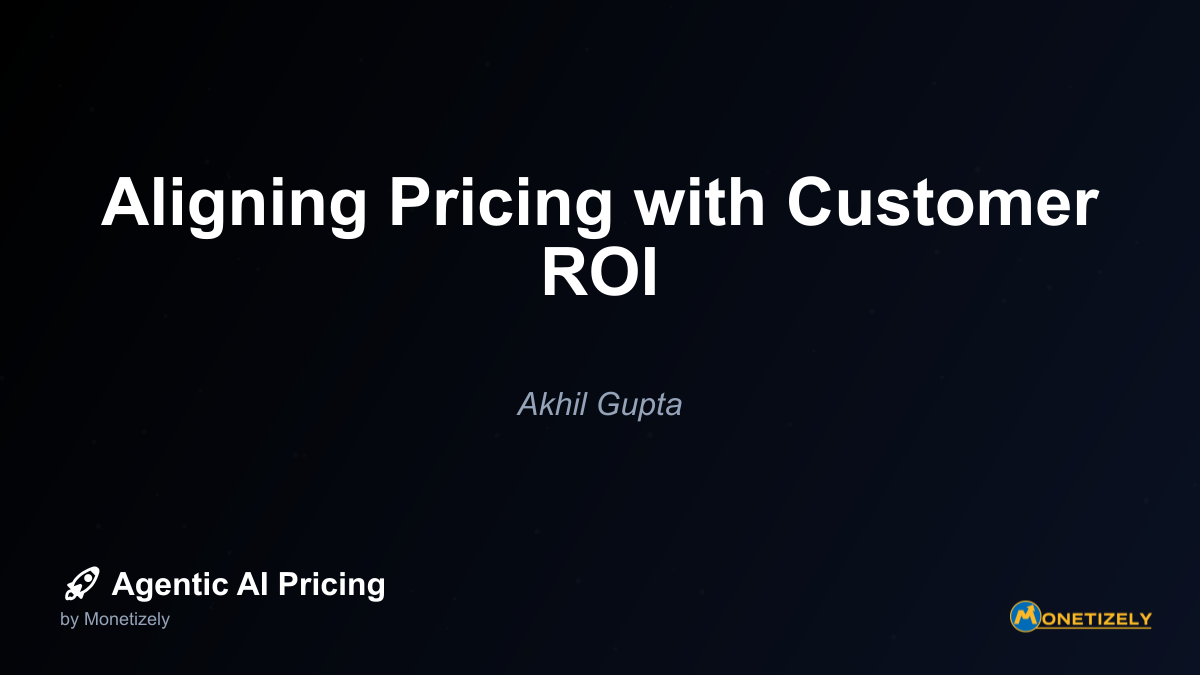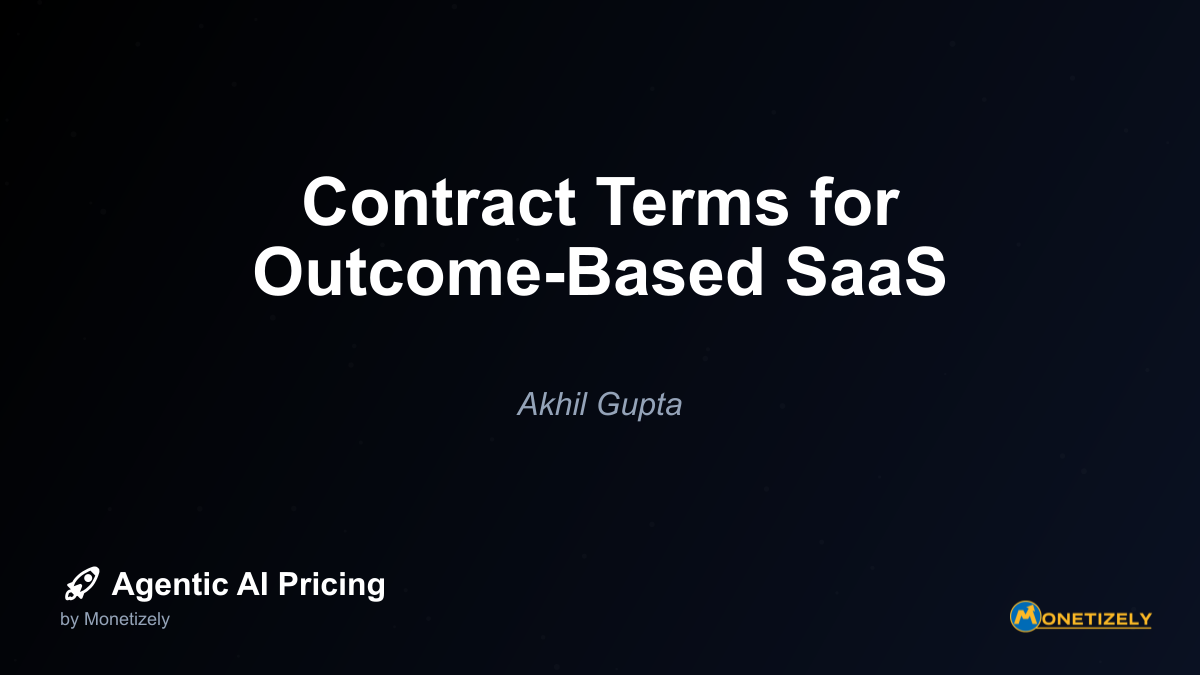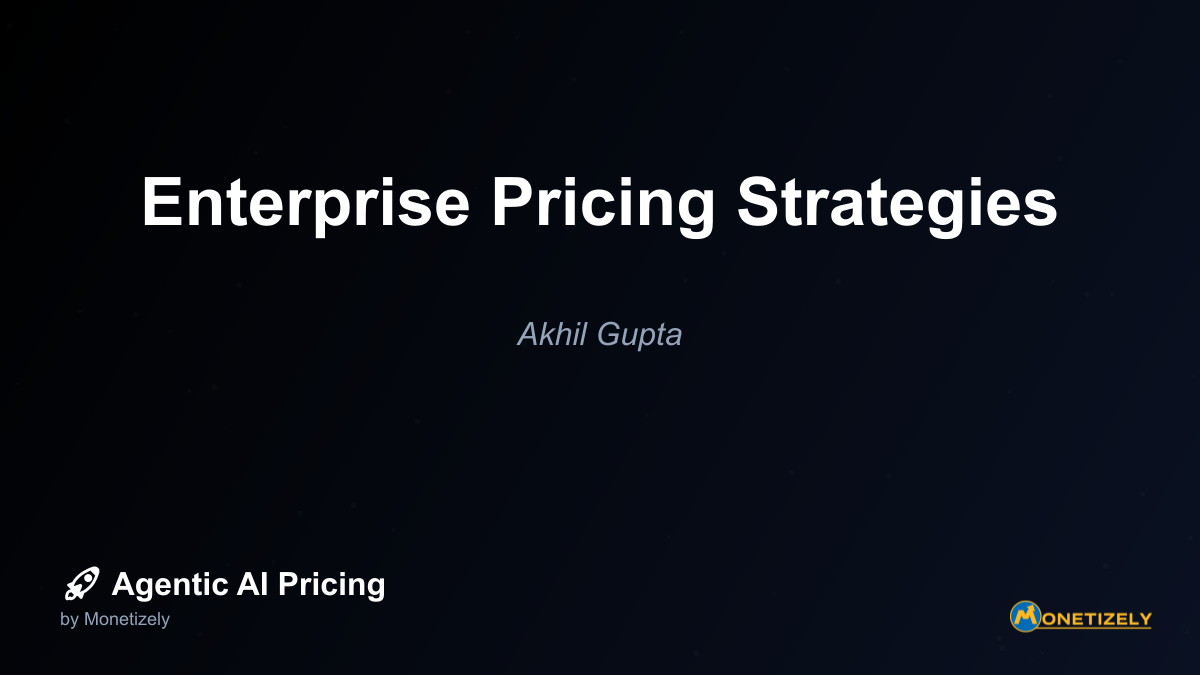· Akhil Gupta · Pricing Agentic SaaS Products · 11 min read
Tiered Pricing for Agentic SaaS
AI and SaaS Pricing Masterclass
Learn the art of strategic pricing directly from industry experts. Our comprehensive course provides frameworks and methodologies for optimizing your pricing strategy in the evolving AI landscape. Earn a professional certification that can be imported directly to your LinkedIn profile.

In today’s dynamic SaaS landscape, the emergence of agentic AI has transformed how companies approach their pricing strategies. Creating effective tiered pricing models—commonly known as “good-better-best” packages—has become essential for SaaS businesses looking to maximize revenue while delivering value across diverse customer segments. This is especially critical for agentic AI products, where autonomous capabilities and business outcomes drive customer perception of value.
Understanding the Strategic Importance of Tiered Pricing for Agentic AI
Tiered pricing models remain highly effective for agentic AI and SaaS products in 2023-2025, enabling companies to cater to diverse user segments while aligning pricing with value delivered and product outcomes. Unlike traditional software, agentic AI products act autonomously to deliver specific business outcomes rather than merely providing features or usage-based value.
The latest research indicates that SaaS firms typically offer 3-4 pricing tiers, each reflecting different feature sets, usage limits, or service levels. This segmentation addresses the varied needs of customers—from startups to enterprises—enabling a clear upgrade path and maximizing customer lifetime value.
For agentic AI specifically, pricing should be outcome-focused, avoiding flat-rate or per-seat models that may misalign cost and delivered value. This requires strategic structuring of tiers based on the AI’s unique value creation mechanisms.
The Evolution of Tiered Pricing Models for AI Products
Traditional vs. Agentic AI Pricing Approaches
Traditional SaaS pricing models have typically relied on:
- Per-seat or per-user licensing
- Feature-based differentiation
- Simple usage metrics (storage, compute)
Agentic AI products, however, require more sophisticated approaches:
- Outcome or value-based pricing
- Hybrid models combining fixed and variable components
- Pricing tied to autonomous actions or business results
As BCG’s 2025 analysis notes: “As agentic AI offerings become increasingly sophisticated, vendors are shifting from replacing software tasks to providing entirely new capabilities. This requires pricing models that capture incremental value and manage cost fluctuations.”
Hybrid Pricing Models Gaining Traction
The market is increasingly moving toward hybrid pricing models that combine:
- Base subscription fees (for access and basic features)
- Usage-based components (tokens, API calls, compute)
- Outcome-based elements (successful automations, business results)
This approach helps balance predictability for customers with fair value capture for vendors, especially important given the computational intensity of AI workloads.
Building Effective Good-Better-Best Tiers for Agentic AI
Step 1: Define Your Customer Segments and Value Metrics
Before structuring tiers, identify your distinct customer segments and understand their needs, pain points, and willingness to pay. For agentic AI products, segment customers based on:
- Company size and budget
- Use case complexity
- Required autonomy level
- Integration needs
- Compliance requirements
Next, choose a key value metric that reflects how customers derive value from your AI product. This could be:
- Active users or agents deployed
- Autonomous tasks completed
- Business outcomes achieved
- API calls or token usage
- Data processed
This value metric becomes the foundation for scaling your pricing tiers in a way that aligns with customer value perception.
Step 2: Establish Clear Tier Goals and Positioning
Each tier in your good-better-best structure should have a distinct purpose:
Good (Base Tier):
- Provides basic functionality to solve essential customer problems
- Targets budget-conscious startups or small teams
- Places limits on features and usage to encourage upgrading
- Focuses on proving initial value with minimal complexity
Better (Mid Tier):
- Represents your most compelling and high-margin plan
- Targets growing organizations needing more features, capacity, and support
- Serves as your main revenue driver with clear value over the base tier
- Balances cost and capabilities for mainstream users
Best (Premium Tier):
- Offers full feature access, premium support, and enterprise capabilities
- Targets large enterprises or mission-critical use cases
- Includes advanced security, compliance, and custom integrations
- Priced high to maximize revenue without cannibalizing the mid-tier
Step 3: Allocate Features and Capabilities Strategically
For agentic AI products, feature allocation across tiers requires careful consideration of both technical capabilities and business value. Consider these allocation principles:
Base Tier (Good):
- Limited number of AI agents or workflows
- Basic automation capabilities
- Standard response times
- Limited customization
- Core integrations only
- Basic reporting and analytics
Mid Tier (Better):
- Increased number of AI agents or workflows
- Advanced automation capabilities
- Faster response times
- Moderate customization options
- Expanded integrations
- Enhanced reporting and analytics
- Priority support
Premium Tier (Best):
- Unlimited AI agents or workflows
- Full automation capabilities
- Fastest response times
- Extensive customization options
- Full integration ecosystem
- Advanced analytics and insights
- Dedicated support with SLAs
- Custom development
Analyst Medina emphasizes: “Moving to a workflow allows you to move out of the treadmill of charging for pure work to charging for work that is worth something to somebody.”
This approach ensures that higher tiers deliver progressively greater value, justifying the price increase and encouraging upgrades.
Step 4: Determine Pricing Thresholds and Structure
Setting appropriate pricing thresholds is critical to the success of your tiered strategy. Consider these factors:
Value-Based Pricing:
- Price in proportion to the business value delivered, not just resource cost
- Consider the ROI customers receive from each tier
- Align with customer willingness to pay at each segment
Price Spacing:
- Maintain clear price differentiation between tiers (typically 2-3x from tier to tier)
- Too close pricing leads to cannibalization of higher tiers
- Too distant pricing creates adoption barriers
Hybrid Pricing Components:
- Base subscription for access and core features
- Usage-based elements for variable consumption
- Outcome-based components for value alignment
From Monetizely’s pricing guide: “Anchor your pricing on one or two primary metrics. Keep it explainable, predictable, and aligned to value. Avoid complexity traps that confuse buyers and stall growth.”
Step 5: Test and Iterate
Effective tiered pricing isn’t static—it requires continuous testing and refinement:
- A/B testing: Test different tier structures with market segments
- Customer interviews: Gather feedback on perceived value and pricing
- Usage analysis: Monitor how customers utilize features across tiers
- Competitive benchmarking: Track industry pricing trends
- Conversion metrics: Measure upgrade rates between tiers
This data-driven approach ensures your pricing evolves with customer needs and market conditions.
Case Studies: Successful Tiered Pricing for AI Products
OpenAI’s Tiered Approach
OpenAI uses a tiered pricing model that combines fixed tiers and usage-based components:
- Free tier: Limited access for experimentation
- Plus tier ($20/month): Increased access and performance
- Team tier: Collaborative features and shared billing
- Enterprise tier: Custom limits, priority access, and support
This approach enabled OpenAI to rapidly scale users while capturing greater revenue from high-volume enterprise customers. It balances accessibility and profitability simultaneously.
Initially, OpenAI’s pricing was less transparent and mostly usage-based, which confused some users and limited adoption. Introducing clear tiered tiers with defined feature sets and usage caps improved clarity and customer satisfaction, demonstrating the importance of transparent tier differentiation.
Computer Vision SaaS with Usage and Tiered Pricing
A computer vision AI company adopted a hybrid pricing model with tiered levels based on image processing volume per month:
- Starter tier: Up to 5,000 images/month at $199
- Growth tier: Up to 20,000 images/month at $499
- Enterprise tier: Custom volume with volume discounts
This model aligned costs with actual customer value, reducing churn among smaller clients and maximizing revenues from high-volume users. The tiered strategy enabled straightforward upselling pathways.
Initially, the company had overcomplicated tiers with overlapping features, causing confusion and slowing new user acquisition. Simplifying tiers to distinct volume thresholds and clarifying included features helped turnaround adoption rates.
Technical Considerations for Implementing Tiered Pricing
Integration Complexity and Costs
The complexity of agentic AI deployment creates several technical challenges:
- Measuring and proving value: Tracking and demonstrating the impact of AI agents
- Integration with existing systems: CRM, ITSM, ERP connections
- Usage monitoring and billing: Accurately tracking consumption metrics
- Feature gating: Controlling access based on tier entitlements
- Scalability: Ensuring performance as usage grows
These factors must be considered when designing tier structures and pricing thresholds.
Cost Management for AI Operations
Agentic AI products often have significant backend costs that fluctuate with usage:
- LLM API costs: Fees for language model usage
- Compute resources: Processing power for AI operations
- Storage and data management: Handling training and operational data
- Development and maintenance: Ongoing improvement of AI capabilities
These costs must be factored into tier pricing to ensure profitability while remaining competitive.
Competitive Analysis: How Major Players Structure Their Tiers
OpenAI vs. Anthropic vs. Google vs. Microsoft
Major AI players employ distinct approaches to tiered pricing:
| Provider | Pricing Strategy | Package Structure | Key Features & Insights |
|---|---|---|---|
| OpenAI | Flexible, token-based usage pricing with tiered subscriptions; volume discounts at scale | - Pay-per-use (per 1,000 tokens) - ChatGPT Plus subscription - Enterprise/custom packages | - Pricing split by input/output tokens - Offers free to enterprise levels - Transparent usage-based costs |
| Anthropic | Transparent, simple token-based pricing focusing on language models | - Multiple Claude models with different costs - Enterprise volume discounts | - No image/speech APIs, focuses on high-quality language AI with safety - Pricing emphasizes predictability |
| Microsoft | Value-based pricing integrated with SaaS products; hybrid seat + usage pricing | - AI-enhanced products as add-ons - Per user/per bot pricing | - Pricing ties closely to delivered value - Hybrid models balance fixed user fees + usage |
| Token or character usage pricing, custom enterprise deals | - Cloud AI services priced by units - Tiered plans for different models | - Flexible, scalable, API-based pricing - Targets both developers and enterprises |
What we can learn from these approaches:
- Usage-based tokens/units are fundamental: Charging per input/output token or per task scales costs directly with consumption
- Tiered plans cover the full spectrum: From free or low-cost entry points to enterprise-custom plans
- Transparency and predictability matter: Clear pricing tables and calculators improve trust
- Value-based models are emerging: Pricing by delivered value rather than raw usage aligns cost with impact
Future Trends in Tiered Pricing for Agentic AI
The future of tiered pricing for agentic AI and SaaS products is moving toward more dynamic, value-based, and outcome-focused models that reflect the autonomous capabilities and business impact of AI agents.
Key trends to watch:
Transition from seat-based to “agentic seat” or task-based pricing: Vendors increasingly license AI agent instances rather than simply charging per user
Emergence of blended and consumption-based models: Pricing will often combine a fixed base fee with variable costs tied to token usage, API calls, or measured business outcomes
Outcome- or value-based pricing models: Especially for AI agents, pricing will link to actual business value delivered rather than raw usage metrics
Regulatory considerations: New regulations are expected to affect pricing transparency, fairness, and data usage policies, potentially requiring vendors to provide clearer cost structures
Tiered pricing evolution: While tiered plans persist, they will incorporate more granular, AI-specific feature sets and possibly volume or performance triggers
A Framework for Creating Your Tiered Pricing Strategy
To implement an effective good-better-best pricing strategy for your agentic AI product, follow this systematic framework:
1. Define Your Value Metrics and Customer Segments
- Identify 2-3 key metrics that directly correlate with customer value
- Segment your market based on needs, budget, and use case complexity
- Understand the value drivers for each segment
2. Structure Your Tiers Strategically
Good (Base Tier): Entry-level offering with core functionality
- Limited but valuable AI capabilities
- Usage caps that allow meaningful testing
- Basic support and standard SLAs
Better (Mid Tier): Your primary revenue driver
- Enhanced AI capabilities and customization
- Higher usage limits and performance
- Improved support and faster SLAs
- Additional integrations and analytics
Best (Premium Tier): Full-featured offering for enterprise needs
- Complete AI capabilities and unlimited customization
- Highest usage limits or unlimited usage
- Premium support with dedicated resources
- Advanced security, compliance, and enterprise features
3. Price Based on Value, Not Cost
- Set prices based on customer willingness to pay and perceived value
- Maintain appropriate price spacing between tiers (typically 2-3x)
- Consider hybrid pricing components to align with usage patterns
4. Communicate Value Clearly
- Emphasize business outcomes, not technical specifications
- Use comparison tables to highlight tier differences
- Provide pricing calculators for transparency
- Showcase ROI and success metrics
5. Implement and Measure
- Use feature flags and entitlement systems to control access
- Track upgrade rates and tier distribution
- Monitor usage patterns and customer feedback
- Iterate based on market response and competitive landscape
Common Pitfalls to Avoid
When implementing tiered pricing for agentic AI products, be aware of these common mistakes:
Overloading the base tier: Giving too much value in the entry-level offering reduces incentives to upgrade
Insufficient tier differentiation: Failing to clearly distinguish the value between tiers creates confusion and hesitation
Pricing complexity: Using too many metrics or complicated formulas makes it difficult for customers to predict costs
Misaligned value metrics: Choosing metrics that don’t correlate with customer value perception leads to dissatisfaction
Ignoring usage patterns: Failing to analyze how customers actually use your product results in missed optimization opportunities
Static pricing: Not evolving your pricing strategy as your product and market mature limits growth potential
Implementing Your Tiered Strategy: Practical Steps
1. Conduct Market Research
- Analyze competitor pricing structures and positioning
- Survey potential customers about feature preferences and willingness to pay
- Identify key value drivers in your product
2. Build Your Tier Structure
- Define clear feature sets for each tier
- Establish usage limits and entitlements
- Set pricing thresholds with appropriate spacing
3. Develop Technical Infrastructure
- Implement feature flagging and entitlement systems
- Create usage monitoring and analytics capabilities
- Build billing and subscription management tools
4. Create Marketing and Sales Materials
- Develop clear pricing pages with tier comparisons
- Create ROI calculators and value propositions
- Train sales teams on positioning and objection handling
5. Launch, Monitor, and Iterate
- Roll out your tiered pricing strategy
- Track key metrics: conversion rates, tier distribution, upgrade paths
- Gather customer feedback and adjust as needed
Conclusion: The Strategic Imperative of Well-Designed Tiers
Tiered pricing is not merely a pricing strategy—it’s a product strategy that shapes how customers perceive, adopt, and expand their use of your agentic AI solution. When done right, it creates a natural progression that aligns with customer growth and value realization.
The most successful agentic AI companies recognize that effective tiered pricing requires continuous evolution. As the market matures and customer needs change, your pricing structure must adapt accordingly. This means regular analysis of usage patterns, competitive positioning, and customer feedback to refine your approach.
By following the framework outlined in this article and learning from the successes and failures of market leaders, you can create a tiered pricing strategy that maximizes both customer satisfaction and revenue growth. Remember that the goal is not simply to segment your offering, but to create a compelling value narrative that guides customers to the right solution for their needs—and encourages them to grow with you over time.
For organizations looking to implement or refine their tiered pricing approach for agentic AI products, start by clearly defining your value metrics, structuring tiers around meaningful capability differences, and communicating value in terms of business outcomes rather than technical features. With these foundations in place, you’ll be well-positioned to capture the full value of your innovative AI solutions.
For a deeper exploration of implementing multi-tier AI pricing while balancing advantages and complexity, consider our comprehensive guide that examines the nuances of this approach in greater detail.
Co-Founder & COO
Akhil is an Engineering leader with over 16+ years of experience in building, managing and scaling web-scale, high throughput enterprise applications and teams. He has worked with and led technology teams at FabAlley, BuildSupply and Healthians. He is a graduate from Delhi College of Engineering and UC Berkeley certified CTO.
Pricing Strategy Audit
Let our experts analyze your current pricing strategy and identify opportunities for improvement. Our data-driven assessment will help you unlock untapped revenue potential and optimize your AI pricing approach.




